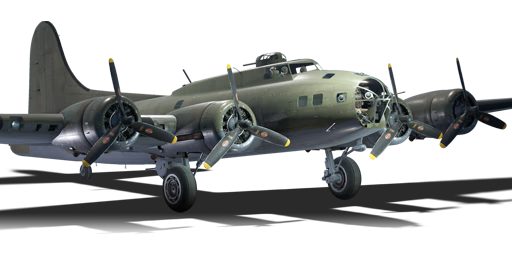



The B-17E/L is an American bomber. It has been in the game since the start of the Open Beta Test prior to Update 1.27.
The B-17 Flying Fortress has the sole purpose of being a high-altitude bomber targeting land fortifications, airfields and bases. Despite its impressive bomb capacity, it is not recommended to target moving ground units, such as tanks or armoured cars, especially when they are travelling in tight columns due to the inaccuracy of your bombs at high altitudes and the ability for the AI on the ground to perform evasive manoeuvres when bombs are falling onto their position. When you first spawn in a game using the B-17, it is best if you find a formation of friendly bombers to maximize your chances of survival.
Unlike the preceding variant of the B-17, the B-17E/Late sports the Sperry Ball turret on the belly of the aircraft, thus ensuring complete protection of the belly of the aircraft. However, you still have the main drawback as the preceding B-17E: the lack of nose defences. While you do have .30 calibre guns on the nose, it is relatively inadequate at the battle rating, and nearly worthless in an uptier. On the other hand, this model of the B-17 does have more armour than its predecessors.
flaps
flaps
flaps
brake
| Belt | Belt filling | Armor penetration (mm) at a distance: | |||||
|---|---|---|---|---|---|---|---|
| 10 m | 100 m | 500 m | 1000 m | 1500 m | 2000 m | ||
| API-T/AP/AP/I | 30 | 27 | 20 | 13 | 9 | 6 | |
| AP/AP/AP/API-T | 30 | 27 | 20 | 13 | 9 | 6 | |
| AP-I/I/AP-I/API-T | 28 | 26 | 18 | 11 | 7 | 4 | |
| Belt | Belt filling | Armor penetration (mm) at a distance: | |||||
|---|---|---|---|---|---|---|---|
| 10 m | 100 m | 500 m | 1000 m | 1500 m | 2000 m | ||
| API-T/AP/AP/I | 30 | 27 | 20 | 13 | 9 | 6 | |
| AP/AP/AP/API-T | 30 | 27 | 20 | 13 | 9 | 6 | |
| AP-I/I/AP-I/API-T | 28 | 26 | 18 | 11 | 7 | 4 | |
| Belt | Belt filling | Armor penetration (mm) at a distance: | |||||
|---|---|---|---|---|---|---|---|
| 10 m | 100 m | 500 m | 1000 m | 1500 m | 2000 m | ||
| T/Ball/Ball/AP/I | 13 | 12 | 7 | 3 | 2 | 0 | |
| T/AP/AP/AP/I | 13 | 12 | 7 | 3 | 2 | 0 | |












Flight performance | |
|---|---|
Survivability |
|---|
Weaponry | |
|---|---|